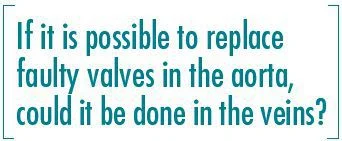HealthManagement, IQ_2012_06_venus
Innovation and constant technical development are some of the hallmarks of interventional radiology (IR). One area in which interventional radiologists are applying their ingenuity is in the search for a new solution to chronic venous insufficiency (CVI).
Thanks to the great contribution of Prof. Elias Brountzos and Prof. Dusan Pavcˇnik, two interventional radiologists in volv ed in this field of research, IQ explains how prosthetic venous valves could become an effective new treatment option.
A Widespread Disease
Many people worldwide suffer from chronic insufficiency of the veins in the legs. Weak and leaky valves in the veins result in the pooling of blood in the legs and raised blood pressure in the local venous system (for further details, see Venous Interventions, page 5).
Venous insufficiency can lead to many symptomatic problems, the most familiar of which being visible varicose veins: a sign of insufficiency in the superficial veins close to the skin.
Symptoms of Chronic Venous Insufficiency:
- Visible red or “broken” vessels
- Visible varicose veins · Disabling pain
- Skin changes including discolouration
- Oedema (swelling due to fluid retention)
- Sclerosis (hardening of the tissues)
- Skin ulceration
A range of treatments are available for superficial varicose veins, including highly effective and minimally invasive options provided by IR.
Treatments for Superficial Venous Insufficiency:
- Foam sclerotherapy
- Radiofrequency ablation
- Laser ablation
- Compression hosiery
- Surgical stripping and ligation
More than Skin Deep
Primary CVI
- uncertain causation
- thought to be congenital
Secondary CVI
- post-thrombotic
- deep vein thrombosis damages or destroys valves of the deep veins
When the deep veins are affected by CVI, the treatment options are much more limited. Surgical treatments exist such as valve repair, femoral vein transposition or venous segment transplantation. However, the majority of patients with secondary valve insufficiency are not candidates for these procedures due to obstructions or residual thrombus throughout the vein. The few remaining treatment options for these patients include the use of compression stockings and local skin treatment. This is often inadequate and non-healing ulcers can easily develop.
Early Involvement of IR Prevents Later Complications
Interventional radiology has developed techniques for the prevention of secondary venous insufficiency after a DVT. However, thrombolysis and recanalisation of the acute deep venous thrombosis are still unfortunately only offer ed to a minority of patients. The majority of patients are man aged conservatively with anticoagulation only and are at risk of going on to develop secondary CVI of the deep veins. An effective therapy is needed for these patients and, once again, IR might be able to offer the solution.
Treating the Source of the Problem
In the field of cardiac surgery, the implantation of special - ly designed artificial valves is already routine. Furthermore, prosthetic valves can now be put in place with mi ni mally invasive catheter procedures for selected patients, who are unsuitable for open surgery. If it is possible to replace faulty valves in the aorta, could it be done in the veins?
In 1981, IR pioneer Charles Dotter proposed the minimally invasive implantation of an artificial venous valve. This was suggested as a solution for patients with chronic deep venous insufficiency for whom surgical treatment had failed.
Since then, much research has gone into the development of catheter-based valves that are suitable for percutaneous placement into insufficient veins.
Designing a Solution
Many designs for prosthetic venous valves have been conceived but despite significant progress in the area there are still many challenges to be overcome before they are seen in the clinic.
One of the major difficulties encountered with all vascular prosthetics is neointimal hyperplasia: a thickening and growth of the blood vessel’s lining after a device is put in position. This is a natural response when a foreign body comes into contact with the blood vessel but can lead to a narrowing (stenosis) of the vessel, which restricts blood flow and limits the effectiveness of the treatment.
For useful clinical application, prosthetic venous valves must be compatible with the body, remain in position and keep functioning in the long term.
The Ideal Prosthetic Venous Valve for Treating Deep Venous Insufficiency:
- Good long-term function
- Minimally invasive placement by catheter
- Good biocompatibility
- Low risk of thrombus formation
- No need for anticoagulation medication
IR at the Forefront
One research group that is making great strides in the development of artificial venous valves is that headed by Prof. Dusan Pavcˇnik, at the Dotter Interventional Institute, Oregon, USA. Their concept is to use the biosynthetic valve material, porcine small intestinal submucosa (SIS), which is attached to a metallic square stent frame.
Following promising experimental studies, trials with symptomatic patients have shown good results in the short term. Patients’ symptoms improved and, in some cases, large venous ulcers completely healed. Spurred on by these positive clinical results, the next step is to enhance the long-term functioning of the valve, preventing neointimal hyperplasia so that the leaflets remain in good working condition for longer.
Other than finding a new biomaterial to use instead of SIS, valve functionality could be enhanced by finding a method for SIS leaflets to be covered with vein wall cells. In this way, neointimal hyperplasia might be prevented. The artificial valve might then be allowed to work as if it were a natural part of the vein.
Recognising the great potential of this idea, the Dotter Institute has recently been awarded an NIH R01 grant from the US Department of Health, to investigate this promising technology.
A Small Device With Huge Impact
The clinical availability of a bioprosthetic venous valve would revolutionise the treatment of chronic deep venous insufficiency, a condition for which there is currently no satisfactory standard treatment.
As well as reducing the costs currently spent on longterm care and disease management, bioprosthetic venous valves could also greatly improve the health and quality of life of countless patients around the world.




